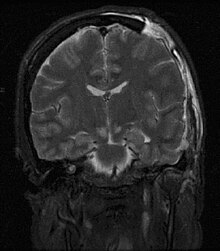Pressure reactivity index

Pressure reactivity index or PRx is a tool for monitoring cerebral autoregulation in the
PRx uses mathematical
Under normal conditions,
Definition
In the original article, it is stated that "Time-averaged values of ICP, ABP, CPP, (CPP = MAP - ICP), and the middle cerebral artery blood FV were calculated using waveform time integration (average values of 256 consecutive samples) for 5-second intervals. Linear (Pearson's) moving correlation coefficients between 40 past consecutive 5-second averages of ICP and ABP, designated as the PRx, were computed. Computations were repeated with a moving window every 5 seconds."[4] Later research has shown that analysis of lower frequency data (minute-by-minute) can have similar results in autoregulation monitoring.[5]
In the 20 year follow up article, they state "we programmed our computers, running ICM (intensive care monitor) software, to calculate a moving correlation coefficient from 30 consecutive 10-s averages of ICP and ABP waveforms. We called this the PRx index (pressure reactivity index)".[2] This is also the definition provided on the homepage promoting ICM+, a software that can calculate PRx. [6]
In 2022 a retrospective analysis identified five types of artifacts in terms of pressure reactivity index: "rectangular, fast impulse, isoline drift, saw tooth, and constant ICP value," and concluded that the effects of these artifacts on the PRx index are variable.[7][8]
PRx and outcome prediction
A high PRx indicating disturbed pressure autoregulation predicts poor outcome in traumatic brain injury.[9][4]
PRx as a treatment target
PRx varies with the concurrent cerebral perfusion pressure (CPP) in a U-shaped way.[10] It has been suggested that the CPP with the lowest PRx is optimal (CPPopt) and CPP-values close to optimal have been associated with better outcome.[11][12] CPP values above CPPopt are believed to cause hyperemia, i.e. to high cerebral blood flow that may cause cerebral edema and intracranial hypertension, whereas CPP values below CPPopt are believed to cause hypoperfusion and ischemia resulting in tissue damage.
See also
- Cerebral autoregulation
- Intracranial pressure
- Cushing's triad
References
- ^
- ^ PMID 9218290.
- PMID 24745709.
- ^ "PRx". CPPopt Research. Retrieved 2 November 2020.
- PMC 9448724.
- ^ Center, Charles University Environment. "Investigating the effect of common artifacts on pressure reactivity index". medicalxpress.com. Retrieved 2022-11-17.
- ^ Sorrentino, E., Diedler, J., Kasprowicz, M., Budohoski, K., Haubrich, C., Smielewski, P., Outtrim, J., Manktelow, A., Hutchinson, P. and Pickard, J. (2012). Critical thresholds for cerebrovascular reactivity after traumatic brain injury. Neurocritical care 16, 258-266.
- ^ Czosnyka, M., Smielewski, P., Piechnik, S., Steiner, L.A. and Pickard, J.D. (2001). Cerebral autoregulation following head injury. Journal of neurosurgery 95, 756-763.
- ^ Aries, M.J., Czosnyka, M., Budohoski, K.P., Steiner, L.A., Lavinio, A., Kolias, A.G., Hutchinson, P.J., Brady, K.M., Menon, D.K. and Pickard, J.D. (2012). Continuous determination of optimal cerebral perfusion pressure in traumatic brain injury. Critical care medicine 40, 2456-2463.
- ^ Steiner, L.A., Czosnyka, M., Piechnik, S.K., Smielewski, P., Chatfield, D., Menon, D.K. and Pickard, J.D. (2002). Continuous monitoring of cerebrovascular pressure reactivity allows determination of optimal cerebral perfusion pressure in patients with traumatic brain injury. Critical care medicine 30, 733-738.
